
Features
Applications
Swine
Higher yields and a cost savings with liquid manure
April 11, 2008 by Candace Pollock
Learn more at the Great Lakes Manure Handling Expo, July 9.
 |
| Visitors take a few steps up in the world of separators. Photos By Margaret Land. |
Manure may be a cheaper alternative to high-priced commercial fertilizers, but management is the key to profit and crop performance. Jon Rausch, Ohio State University Extension environmental management program director, says that more Ohio farmers are turning to manure for corn production because of the higher prices of nitrogen, potassium and phosphorus. However, they face the challenge of proper nutrient utilization to maximize results.
“When manure is treated like a nutrient resource, it can be a cost-effective asset to crop production,” he says. “To maximize manure’s value, it must replace other nutrient inputs and be placed where a crop response is expected. Adding nutrients above recommended levels would decrease its value and increase the potential of those nutrients being lost to the environment.”
Existing nutrient levels in the soil, how much manure is applied, how well manure is spread, and how well soil nutrients are maintained with manure application are just some of the variables that can influence the value of manure as a fertilizer resource.
Ohio State University Extension researchers are conducting studies that demonstrate how the value of manure, specifically from swine, depends upon the need for supplemental nutrients, proper manure handling and thorough application practices.
Glen Arnold, an OSU Extension educator for Putnam County, has been working on research that shows side dressing pre-emergence corn in the spring with swine manure produces yields comparable to applying commercial fertilizer. Coming off several years of research which showed that applying swine manure to post-emergence corn produced comparable or higher yields to commercial urea, OSU Extension educators in Putnam and Hancock counties hope to find the same results in treating pre-emergence corn.
 |
| Working demonstrations are for family visits! |
“We want to find out if a farmer can plant corn and then use a dragline manure application system to side dress before the corn even comes up out of the ground,” explains Arnold. “In 2007, we completed research on three pre-emergence corn plots using liquid swine manure as the primary nitrogen source. Two of the three plots yielded the same or higher compared to urea.”
Arnold, who has been leading the research since 2004, will present the latest findings during the Great Lakes Manure Handling Expo being held July 9, 2008 at the Molly Caren Agricultural Center in London, Ohio. He hopes to show farmers that manure application, which is generally practiced in the fall, can be just as valuable in the spring and it could save farmers money, as well. “At today’s fertilizer prices, using manure from livestock could easily save farmers $75 to $100 per acre in purchased fertilizer,” he says.
Not only can springtime manure application potentially fatten a farmer’s wallet, but it can also benefit the environment. “There is less chance for nutrient loss in the spring as opposed to the fall, because the manure is actually going to a growing crop that will utilize its nutrients,” says Arnold. “We’ve always known that manure provides good nutrients for the soil. The idea is to find a way to make better use of it than applying it to bare fields in the fall.”
He adds that farmers could potentially be throwing away an economically valuable resource if a spring or early summer application to growing crops is not a consideration. In Putnam County, for example, if farmers fully utilize the ammonia nitrogen in their liquid swine manure, they could save more than $500,000 annually through reductions in purchased nitrogen, Arnold says. Putnam County is the fourth largest swine producing county in Ohio.
 |
| Agitation action. |
OSU Extension researchers have also found that when potassium and phosphorus have already reached soil saturation levels, the additional potassium and phosphorus from manure would not be utilized, nor would yields increase. “As a result, farmers are losing the economic value of potassium and phosphorus – to the tune of nearly $58 per acre – and both would be better utilized on acres that need those nutrients,” says Rausch. “Ideal conditions of using manure nutrients to its fullest include soil tests that indicate addition of potassium and phosphorus are necessary, an even and uniform process of manure application, and minimizing those nitrogen losses.”
Not only does manure add nutrient value to a crop, it also adds environmental benefits including micronutrients, organics and biologicals – those organisms that make up the ‘living soil’. Though difficult to quantify with direct economic value, manure has been shown to improve soil quality and soil health, increase organic matter content and build water-holding capacities, among other benefits. “When a farmer is looking at 60 cents per pound of commercial nitrogen as fertilizer, using manure not only for the nutrient value, but also for the secondary benefits, might be an alternative to consider,” suggests Rausch. -end-
 |
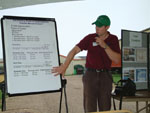 |
| Compost turning creates a stir. | Equating manure to workload and costs. |
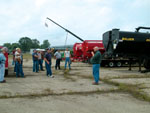 |
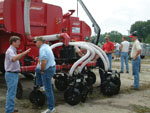 |
| Manufacturers take a few minutes to explain features. | Let’s talk details! |
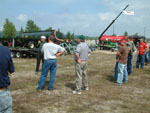 |
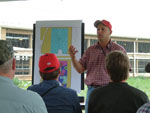 |
| Husky’s Walter Grose takes the mike. | Educational sessions are a learning experience. |
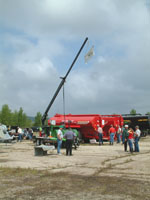 |
Displays provide opportunities to compare features. |
2008 Great Lakes Manure Handling Expo
Manure management issues, such as those discussed by Ohio State University Extension researchers Glen Arnold and Jon Rausch, will be comprehensively covered during the 2008 Great Lakes Manure Handling Expo, taking place July 9 at the Molly Caren Agricultural Center – home of Farm Science Review – in London, Ohio.
The expo is being sponsored by Ohio State University Extension, the Ohio Agricultural Research and Development Center, Michigan State University, Purdue University, Penn State University and Cornell University. Additional sponsors include Ohio Composting and Manure Management and the Midwest Professional Nutrient Applicators Association.
The theme of the Great Lakes Manure Handling Expo is ‘The Economics of Recycling’ and will include commercial field demonstrations, educational demonstrations, educational sessions, and commercial vendor displays.
Session topics that participants can look forward to include: calculating the value of manure nutrients; the benefits of proper equipment calibration; the importance of accurate record-keeping; how communication among applicator, producer and regulatory agency can improve application and the bottom line; safety precautions in manure application and storage; and case studies of farmers who will share their stories about manure management.
Educational demonstrations taking place during the event include: solid manure application rates; liquid manure application rates; preferential flow; calibration of manure application equipment; stockpiling best management practices; compaction; slurry seeding; and equipment safety.
To learn more, log on to http://ohio-environmental.org or http://oema.osu.edu or contact Tami Combs at (614) 292-6625, Jon Rausch at (614) 292-4504; or Mary Wicks at (330) 202-3533. -end-